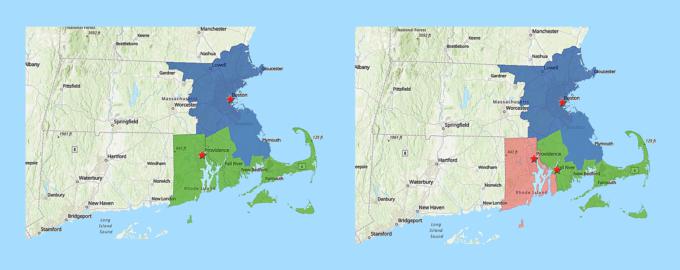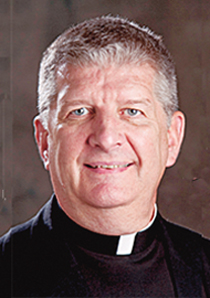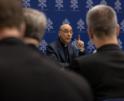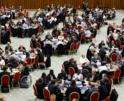
Culture

O’Grady
This is the fourth and final of a series of articles about the changing geography, or better, the borders of the Archdiocese of Boston. These also focus on the Diocese of Providence, which concludes its sesquicentennial observance on June 26, 2022.
1872
The creation in 1872 of the new Diocese of Providence and the ordination of its first bishop was the last change in the borders of the Archdiocese of Boston. The "1872 with RI Map" indicates that change and the first borders of the nascent diocese.
Bishop Thomas F. Hendricken, an Irish immigrant and a priest of the Diocese of Hartford, would lead the new diocese for the next 15 years. From his ordination and installation in 1872, he established almost 30 new parishes in the Ocean State and 13 in the Bay State section of his new diocese. During the early years of his episcopate, Rhode Island saw an economic slowdown and an equal one in immigration. New arrivals speeded up during the later years of Bishop Hendricken's time, with a notable influx of Canadians to the Pawtucket and Providence mills and factories. This required a renewed effort to meet the pastoral needs of French-speaking Canadians. Thus, he increased the number of personal parishes for the new arrivals, especially in Pawtucket. He likewise had to seek priests who could speak French, whether by attracting Canadian priests and seminarians to come to Providence or finding French speakers among his already stretched clergy.
A pet project of the bishop was the construction of a new and larger Cathedral of Sts. Peter and Paul. As had many bishops on the east coast, the Irish-born architect Patrick C. Keely was engaged to design the new cathedral. Raising funds from among his people who were already supporting their own parishes was a challenge, but the bishop met it. The cathedral still serving the diocese today was almost completed by the time of Bishop Hendricken's death on June 11, 1886. His funeral Mass was the first Mass celebrated in his church.
In the meantime, the Boston Diocese was made a metropolitan archdiocese on Feb. 12, 1875. The new Archdiocese of Boston would have its suffragan sees at Burlington, Hartford, Portland, Providence, and Springfield; in 1884, Manchester was separated from Portland and also became a suffragan of Boston. Boston's fourth bishop, Bishop John J. Williams, became the first archbishop and metropolitan of the new ecclesiastical province.
The second Bishop of Providence would be Matthew Harkins, a priest of the Boston Archdiocese. Highly respected by the priests of the archdiocese and a confidant and valued collaborator of Archbishop Williams, he was ordained a bishop in the Providence cathedral on April 14, 1887. He would serve the diocese for 34 years until his death on May 25, 1921. The expansion of the diocese in his time was simply massive. He created 53 new parishes, including personal parishes for Polish, Lithuanian, and Italian arrivals, as well as additional parishes for the growing French-Canadian and Canadian-American population.
A keen supporter of Catholic education, he also promoted Catholic schools on all levels, opening 30 new elementary schools, a dozen new high schools, and not a few of those in personal parishes. He also invited the Dominican Friars to the diocese in 1910, culminating in the first Catholic college in Rhode Island, Providence College. The first building on the new campus, named in honor of Bishop Harkins, was dedicated on May 19, 1921. It was the bishop's last public appearance before his death two years later.
1904
A mere 17 years after his arrival in Providence, the bishop foresaw that the Bay State section of his diocese was ready to be its own diocese. There was much growth in Catholic presence in Rhode Island and the Massachusetts section of his diocese, both in population and the physical presence of the Church. The population saw increases in newcomers from Ireland, Canada, Portugal, the Azores, Italy, Poland, and Lithuania, as well as growth within the existing cities and towns of second- and third-generation Catholics. Accompanying that was the establishment of new churches, schools, convents, rectories, high schools, orphanages, Catholic charitable agencies, budding diocesan social services, and Catholic cemeteries. All contributed to the need for a new diocese.
Among the first actions of the new Pope St. Pius X was the creation of the Diocese of Fall River in 1904, with its cathedral church of St. Mary of the Assumption in the see city.
The diocese would consist of the Massachusetts section of the Providence Diocese, with the borders the same today as the day it was created. One of Bishop Harkins's own and most trusted priests, Father William Stang, whom he had brought to Rhode Island to serve the needs of German Catholics, was named the first bishop of the new diocese and ordained a bishop in Providence's cathedral on May 1, 1904. Sadly, the bishop only lived for three years at the helm of Fall River before dying unexpectedly on Feb. 2, 1907.
There were additional diocesan border changes, but not until 1950. Pope Pius XII separated Worcester County in Massachusetts from the Springfield Diocese and created the new Diocese of Worcester. The same pope, just a few years later, in 1953, created two new dioceses in Connecticut, separating Fairfield, the state's westernmost county, from Hartford and establishing the new see of Bridgeport; and four eastern counties creating the new Diocese of Norwich. At the same time, Hartford was named a metropolitan archdiocese with the two new Connecticut sees and Providence as its three suffragan sees. As an interesting side note, Worcester became the first single-county diocese in the U.S. and, in 1953, Bridgeport the second. The only other one in our country to date is the Diocese of Orange in California, created from the sprawling Archdiocese of Los Angeles during the nation's bicentennial year, 1976. Norwich maintains a distinction of having Fishers Island, New York, in its territory. One of the few dioceses in the U.S. that crosses state lines.
The quick tour of New England's Roman Catholic dioceses through the four articles in this series reveals in outline and sketch the growth of the Church. The waves of new Catholics who joined the tiny group in the colonial era swelled churches and demanded schools, social and charitable services, healthcare facilities, colleges and universities. It was the Catholic faithful who both asked for and supported all of these endeavors. Their bishops, priests, and women and men religious rose to the challenge and together grew the Church in New England. Trusting the providence of God and their tenacious attachment to their faith, they prove "nothing is impossible with God."
One final note: The Pilot staff benefits greatly from the cooperation and collaboration between and among many people in the offices at the Archdiocesan Pastoral Center. This series is a fine example of one such collaboration. Special thanks to Violet Hurst in the Archdiocesan Archives, who created the maps in this series. The Archives is our closest neighbor in the Pastoral Center, and we find ourselves back and forth regularly and happily.
Recent articles in the Culture & Events section
-
'Dignitas' and the mediaRussell Shaw
-
Scripture Reflection for April 14, 2024, Third Sunday of EasterDeacon Greg Kandra
-
St. Helena's House is established in the South EndThomas Lester
-
Is this synodality?Russell Shaw
-
Poking the hornet's nest of IVFFather Tadeusz Pacholczyk


















